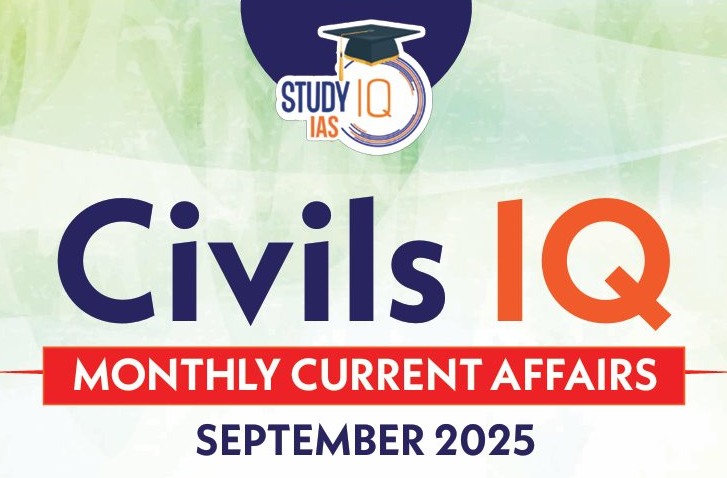Daily Quiz 19 February 2025
Quiz-summary
0 of 5 questions completed
Questions:
- 1
- 2
- 3
- 4
- 5
Information
- Click on – ‘Start Quiz’ button
- Solve Questions
- Click on ‘Next’ button
- Click on ‘Finish Quiz’ button
- Now click on ‘View Questions’ button – here you will see solutions and links.
- The test contains a total of 5 questions.
- Click on the most appropriate option to mark it as your answer.
- You will be awarded Two marks for each correct answer.
- You can change your answer by clicking on some other option.
- A Number list of all questions appears at the top side of the screen.
- You can access the questions in any order by clicking on the question number given on the number list.
- You can use rough sheets while taking the test.
- Do not use calculators, log tables, dictionaries, or any other printed/online reference material during the test.
- Do not click the button “Finish Quiz” before completing the test. A test once submitted cannot be resumed.
You have already completed the quiz before. Hence you can not start it again.
Quiz is loading...
You must sign in or sign up to start the quiz.
You have to finish following quiz, to start this quiz:
- 1
- 2
- 3
- 4
- 5
- Answered
- Review
-
Question 1 of 5
1. Question
1 pointsConsider the following statements:
- An Einstein ring is an example of gravitational lensing.
- General theory of relativity predicts that light could bend and brighten around objects across the cosmos.
- Einstein rings are not visible to the naked eye.
How many of the above statements are correct?
Correct
Answer: C
Explanation:
- Statement 1 is correct: An Einstein ring is a ring of light around a form of dark matter, galaxy or cluster of galaxies. It is essentially an example of gravitational lensing. Gravitational lensing is a phenomenon which occurs when a massive celestial body — such as a galaxy or cluster of galaxies — creates a gravitational field which distorts and amplifies the light from distant galaxies that are behind it but in the same line of sight, according to a report on the website of National Aeronautics and Space Administration (NASA). The body causing the light to curve is called a gravitational lens.
- Statement 2 is correct: Einstein rings are named after mathematician and physicist Albert Einstein, whose general theory of relativity predicted that light could bend and brighten around objects across the cosmos. The first Einstein ring was discovered in 1987, and since then, several more have been discovered. However, it remains unclear how many such rings exist. Notably, they are extremely rare — less than 1% of galaxies have an Einstein ring, according to experts.
- Statement 3 is correct: Einstein rings are not visible to the naked eye, and can be observed only through space telescopes such as Euclid.
Incorrect
Answer: C
Explanation:
- Statement 1 is correct: An Einstein ring is a ring of light around a form of dark matter, galaxy or cluster of galaxies. It is essentially an example of gravitational lensing. Gravitational lensing is a phenomenon which occurs when a massive celestial body — such as a galaxy or cluster of galaxies — creates a gravitational field which distorts and amplifies the light from distant galaxies that are behind it but in the same line of sight, according to a report on the website of National Aeronautics and Space Administration (NASA). The body causing the light to curve is called a gravitational lens.
- Statement 2 is correct: Einstein rings are named after mathematician and physicist Albert Einstein, whose general theory of relativity predicted that light could bend and brighten around objects across the cosmos. The first Einstein ring was discovered in 1987, and since then, several more have been discovered. However, it remains unclear how many such rings exist. Notably, they are extremely rare — less than 1% of galaxies have an Einstein ring, according to experts.
- Statement 3 is correct: Einstein rings are not visible to the naked eye, and can be observed only through space telescopes such as Euclid.
-
Question 2 of 5
2. Question
1 pointsConsider the following statements with reference to Iguana species:
- All iguanas have colors that are vivid and bright.
- Some iguanas are found in trees of a tropical rainforest.
- All iguanas are herbivores, eating fruits, flower buds, and young leaves.
How many of the above statements are correct?
Correct
Answer: A
Explanation:
- Statement 1 is not correct: While some iguanas have colors that are vivid and bright, others have rather dull colors. Because iguanas can be found in a variety of habitats, each species has its own unique adaptations. The marine iguana of the Galápagos Islands is a skillful swimmer, and its black coloration helps it to warm its body after swimming in the cold ocean.
- Statement 2 is correct: Green iguanas are at home high in the trees of a tropical rainforest, while still other iguanas have adaptations that allow them to live successfully in the dry, hot desert or rocky areas.
Statement 3 is not correct: Fiji’s iguanas inhabit a multitude of habitats, from coastal swamps and lowland forests to rainforests on Fiji’s volcanic slopes. Highly arboreal, they have long toes with sharp claws and long tails for balance in the treetops. Rarely seen on the ground, banded iguanas move from tree to tree by using the overlapping branches. They are omnivorous, feeding on leaves, flowers, fruits, and small insects. Most iguanas are herbivores, eating fruits, flower buds, and young leaves. Some also eat the occasional juicy mealworm or wax worm. The marine iguana dives in the ocean to scrape algae from rocks.
Incorrect
Answer: A
Explanation:
- Statement 1 is not correct: While some iguanas have colors that are vivid and bright, others have rather dull colors. Because iguanas can be found in a variety of habitats, each species has its own unique adaptations. The marine iguana of the Galápagos Islands is a skillful swimmer, and its black coloration helps it to warm its body after swimming in the cold ocean.
- Statement 2 is correct: Green iguanas are at home high in the trees of a tropical rainforest, while still other iguanas have adaptations that allow them to live successfully in the dry, hot desert or rocky areas.
Statement 3 is not correct: Fiji’s iguanas inhabit a multitude of habitats, from coastal swamps and lowland forests to rainforests on Fiji’s volcanic slopes. Highly arboreal, they have long toes with sharp claws and long tails for balance in the treetops. Rarely seen on the ground, banded iguanas move from tree to tree by using the overlapping branches. They are omnivorous, feeding on leaves, flowers, fruits, and small insects. Most iguanas are herbivores, eating fruits, flower buds, and young leaves. Some also eat the occasional juicy mealworm or wax worm. The marine iguana dives in the ocean to scrape algae from rocks.
-
Question 3 of 5
3. Question
1 pointsConsider the following:
- To establish a dynamic land bank for plantations accessible via a dedicated web portal.
- Encouraging Government institutions/Non-Government Organisations to select Plantation Blocks for encouraging afforestation.
- Issuance of Green Credits to serve as a key incentive for entities engaging in tree plantation.
How many of the above are objectives of the Green Credit Programme (GCP)?
Correct
Answer: C
Explanation:
- The Green Credit Rules have been notified by the Government of India on 12th October 2023 under the Environment Protection Act, 1986, as mechanism to encourage voluntary plantation activity across the country, resulting in award of Green Credits and to build an inventory of degraded land which can be utilised for Afforestation programmes
- Objectives of the Green Credit Programme (GCP)
- GCP aims to establish a dynamic land bank for plantations accessible via a dedicated web portal. This facility enables the registration of degraded forest lands by Forest departments. The inventory thus formed becomes a valuable resource available for voluntary plantation activities.
- Encouraging Government institutions/Public Sector Undertakings /Non-Government Organisations/Private Companies /Organisations/Philanthropies/Individuals/ Group of Individuals registered under Societies Registration Act to select Plantation Blocks from the registered Plantation blocks for encouraging afforestation.
- Issuance of Green Credits: Green Credits serve as a key incentive for entities engaging in tree plantation. The issuance follows specific methodologies and guidelines stipulated by the Administrator.
Digital Processes: The GCP streamlines its operations through technology-based tools like a web platform and a registry. These digital resources ensure seamless registration, verification, and monitoring of plantation-related activities.
Incorrect
Answer: C
Explanation:
- The Green Credit Rules have been notified by the Government of India on 12th October 2023 under the Environment Protection Act, 1986, as mechanism to encourage voluntary plantation activity across the country, resulting in award of Green Credits and to build an inventory of degraded land which can be utilised for Afforestation programmes
- Objectives of the Green Credit Programme (GCP)
- GCP aims to establish a dynamic land bank for plantations accessible via a dedicated web portal. This facility enables the registration of degraded forest lands by Forest departments. The inventory thus formed becomes a valuable resource available for voluntary plantation activities.
- Encouraging Government institutions/Public Sector Undertakings /Non-Government Organisations/Private Companies /Organisations/Philanthropies/Individuals/ Group of Individuals registered under Societies Registration Act to select Plantation Blocks from the registered Plantation blocks for encouraging afforestation.
- Issuance of Green Credits: Green Credits serve as a key incentive for entities engaging in tree plantation. The issuance follows specific methodologies and guidelines stipulated by the Administrator.
Digital Processes: The GCP streamlines its operations through technology-based tools like a web platform and a registry. These digital resources ensure seamless registration, verification, and monitoring of plantation-related activities.
-
Question 4 of 5
4. Question
1 pointsConsider the following statements with reference to Agreement on Agriculture (AoA):
- It is a Food and Agriculture Organization initiative discussed in the Uruguay Round of Negotiations.
- It contains provisions regarding members’ commitment to reduce Export Subsidies.
- Under the Agreement on Agriculture (AoA), Minimum Support Price (MSP) is categorised as a trade-distorting subsidy.
How many of the above statements are correct?
Correct
Answer: B
Explanation:
- Statement 1 is not correct: After over 7 years of negotiations the Uruguay Round multilateral trade negotiations were concluded on December 15, 1993 and were formally ratified in April 1994 at Marrakesh, Morocco. The World Trade Organisation (WTO) Agreement on Agriculture was one of the many agreements which were negotiated during the Uruguay Round.
- The WTO Agreement on Agriculture contains provisions in 3 broad areas of agriculture and trade policy : market access, domestic support and export subsidies
- Statement 2 is correct: The Agreement contains provisions regarding members commitment to reduce Export Subsidies. Developed countries are required to reduce their export subsidy expenditure by 36% and volume by 21% in 6 years, in equal installment (from 1986 –1990 levels). For developing countries, the percentage cuts are 24% and 14% respectively in equal annual installment over 10 years. The Agreement also specifies that for products not subject to export subsidy reduction commitments, no such subsidies can be granted in the future.
- Statement 3 is correct: Under the WTO’s Agreement on Agriculture (AoA), MSP is categorised as a trade-distorting subsidy. The rationale is that if countries are permitted to provide such subsidies to their farmers, it would give them an unfair advantage in the global market, rendering agricultural products from other countries uncompetitive. As a result, trade-distorting subsidies like MSP are subject to specific limits.
The AoA has significant imbalances. The external reference price (ERP) — an average price established based on the base years of 1986-88 against which MSP is compared to determine trade-distorting subsidies — has not been revised in decades. Consequently, the gap between the MSP and the fixed ERP has widened dramatically due to inflation.
Incorrect
Answer: B
Explanation:
- Statement 1 is not correct: After over 7 years of negotiations the Uruguay Round multilateral trade negotiations were concluded on December 15, 1993 and were formally ratified in April 1994 at Marrakesh, Morocco. The World Trade Organisation (WTO) Agreement on Agriculture was one of the many agreements which were negotiated during the Uruguay Round.
- The WTO Agreement on Agriculture contains provisions in 3 broad areas of agriculture and trade policy : market access, domestic support and export subsidies
- Statement 2 is correct: The Agreement contains provisions regarding members commitment to reduce Export Subsidies. Developed countries are required to reduce their export subsidy expenditure by 36% and volume by 21% in 6 years, in equal installment (from 1986 –1990 levels). For developing countries, the percentage cuts are 24% and 14% respectively in equal annual installment over 10 years. The Agreement also specifies that for products not subject to export subsidy reduction commitments, no such subsidies can be granted in the future.
- Statement 3 is correct: Under the WTO’s Agreement on Agriculture (AoA), MSP is categorised as a trade-distorting subsidy. The rationale is that if countries are permitted to provide such subsidies to their farmers, it would give them an unfair advantage in the global market, rendering agricultural products from other countries uncompetitive. As a result, trade-distorting subsidies like MSP are subject to specific limits.
The AoA has significant imbalances. The external reference price (ERP) — an average price established based on the base years of 1986-88 against which MSP is compared to determine trade-distorting subsidies — has not been revised in decades. Consequently, the gap between the MSP and the fixed ERP has widened dramatically due to inflation.
-
Question 5 of 5
5. Question
1 pointsConsider the following statements:
- Representation of the People Act, 1951 provides for the disqualification of a person convicted of a criminal offence and sentenced to imprisonment for not less than five years.
- In the Association for Democratic Reforms (ADR) case (2002), the Supreme Court mandated the disclosure of criminal records of all candidates contesting elections.
- Election Commission (EC) of India may remove any disqualification or reduce the period of disqualification of a convicted person.
How many of the above statements are correct?
Correct
Answer: B
Explanation:
- Statement 1 is not correct: 8(3) of the Representation of the People Act, 1951 (RP Act, 1951), provides for the disqualification of a person convicted of a criminal offence and sentenced to imprisonment for not less than two years. Such a person is disqualified from contesting elections for a further period of six years from the date of release. Section 8(1) further stipulates that a person convicted under criminal laws for heinous crimes like rape; the Protection of Civil Rights (PCR) act for preaching or practice of untouchability; UAPA for unlawful association; Prevention of Corruption Act etc., will be disqualified irrespective of the period of their sentence and six years after release.
- Statement 2 is correct: The Supreme Court has delivered notable judgments in favour of the decriminalisation of politics. In the Association for Democratic Reforms (ADR) case (2002), it mandated the disclosure of criminal records of all candidates contesting elections.
Statement 3 is correct: Section 11 of the RP Act, 1951 provides that the Election Commission (EC) may remove any disqualification or reduce the period of disqualification of a convicted person. It utilised this power in September 2019, to reduce the disqualification period of Prem Singh Tamang, incumbent Chief Minister of Sikkim, from six years to 13 months which allowed him to contest and win a byelection.
Incorrect
Answer: B
Explanation:
- Statement 1 is not correct: 8(3) of the Representation of the People Act, 1951 (RP Act, 1951), provides for the disqualification of a person convicted of a criminal offence and sentenced to imprisonment for not less than two years. Such a person is disqualified from contesting elections for a further period of six years from the date of release. Section 8(1) further stipulates that a person convicted under criminal laws for heinous crimes like rape; the Protection of Civil Rights (PCR) act for preaching or practice of untouchability; UAPA for unlawful association; Prevention of Corruption Act etc., will be disqualified irrespective of the period of their sentence and six years after release.
- Statement 2 is correct: The Supreme Court has delivered notable judgments in favour of the decriminalisation of politics. In the Association for Democratic Reforms (ADR) case (2002), it mandated the disclosure of criminal records of all candidates contesting elections.
Statement 3 is correct: Section 11 of the RP Act, 1951 provides that the Election Commission (EC) may remove any disqualification or reduce the period of disqualification of a convicted person. It utilised this power in September 2019, to reduce the disqualification period of Prem Singh Tamang, incumbent Chief Minister of Sikkim, from six years to 13 months which allowed him to contest and win a byelection.
Results
0 of 5 questions answered correctly
Your time:
Time has elapsed
You have reached 0 of 0 points, (0)
| Average score |
|
| Your score |
|
Categories
- Not categorized 0%
| Pos. | Name | Entered on | Points | Result |
|---|---|---|---|---|
| Table is loading | ||||
| No data available | ||||
Sharing is caring!


 Daily Quiz 18 September 2025
Daily Quiz 18 September 2025

























